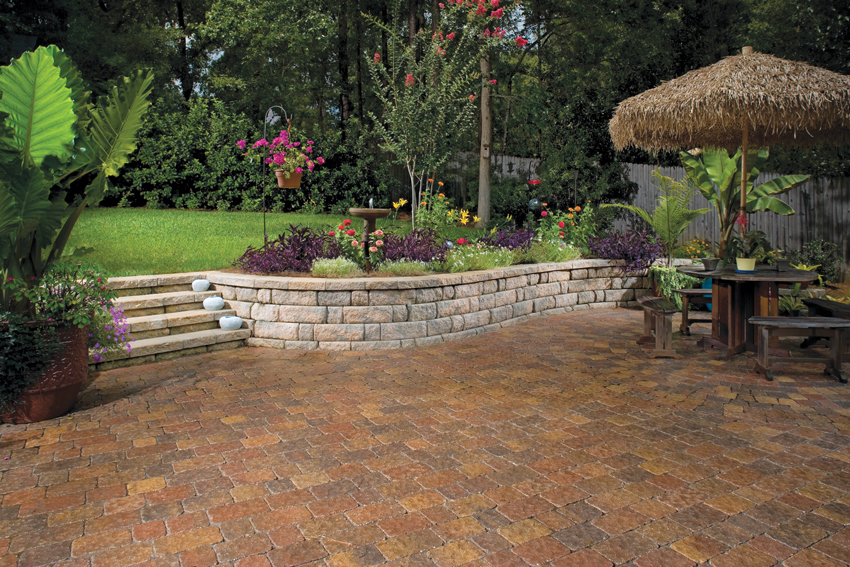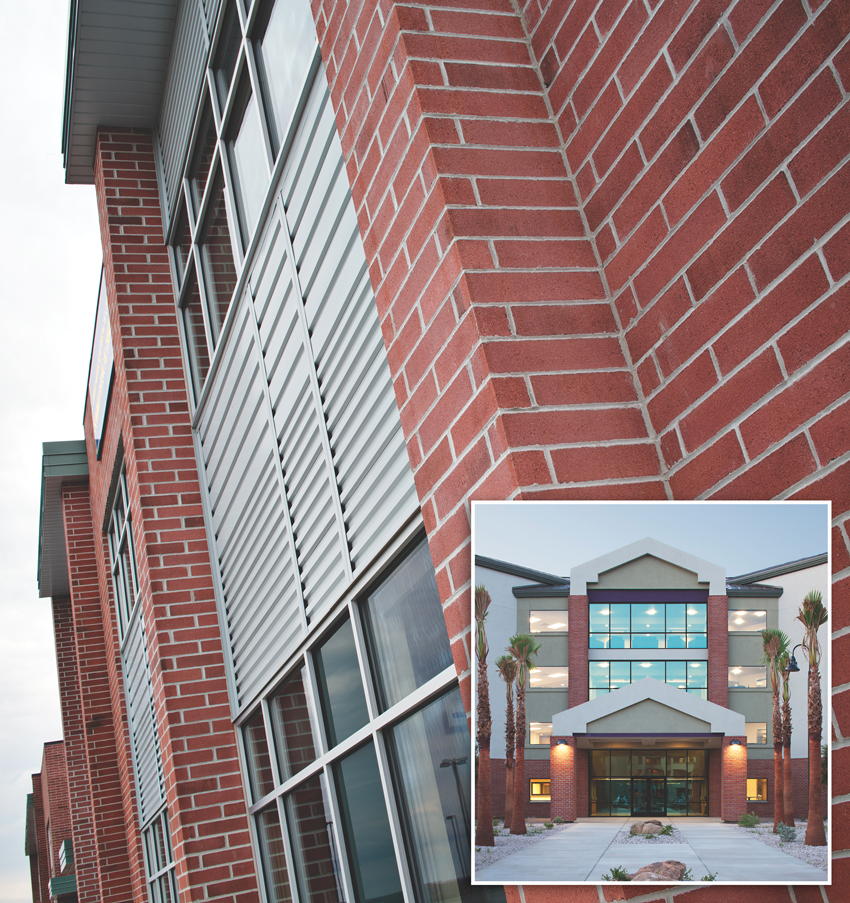Masonry and LEED v4
Advanced products and systems can facilitate compliance
![]() Continuing Education
Continuing Education
Use the following learning objectives to focus your study while reading this month’s Continuing Education article.
Learning Objectives - After reading this article, you will be able to:
- Discuss the ways in which the U.S. Green Building Council’s Leadership in Energy and Environmental Design (LEED) fosters sustainable building.
- Identify the principal areas in which LEED v4 differs from previous versions of LEED.
- Explain how masonry products are already engineered for rapid compliance with new LEED v4 requirements.
- Articulate the advantages of insulated concrete masonry systems and foam panel systems, as they fulfill green building goals and can earn credits in the Materials and Resources category of LEED v4.
The U.S. Green Building Council has rolled out the latest changes to its widely accepted Leadership in Energy and Environmental Design (LEED) green rating system. The changes, known as LEED v4, have increased the stringency of the requirements to comply with the principles of green design. By their very nature, some products are more conducive than others to compliance with the changes in LEED v4. This course will discuss masonry in terms of its inherent ability to meet and exceed requirements of the new model. Also discussed will be several high-performance masonry systems and how they meet energy targets, reduce noise, and meet aesthetic objectives.
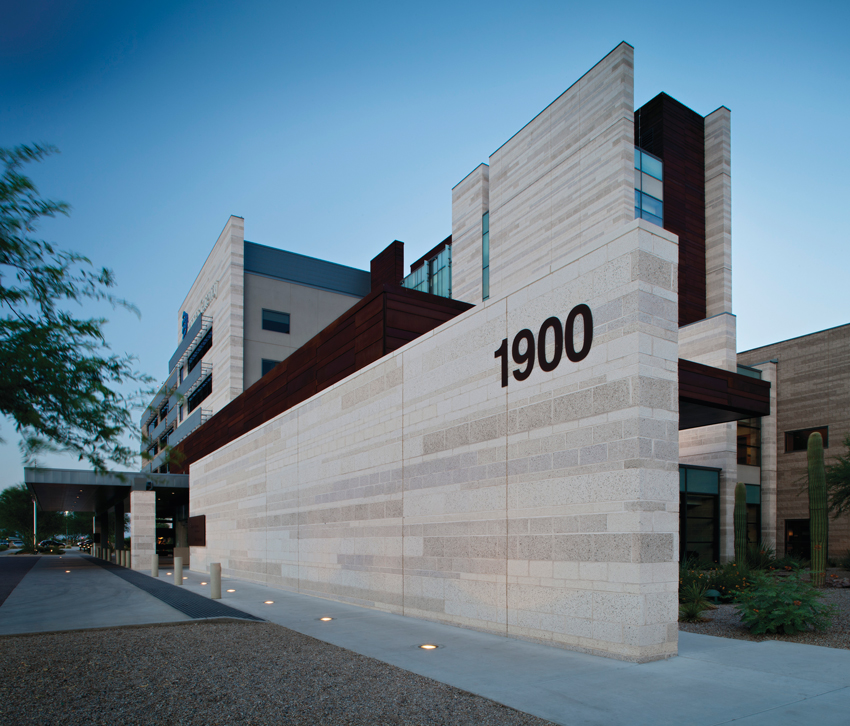
All photos courtesy of Oldcastle Architectural
With the advent of LEED v4, architects have much to consider in choosing building materials.
LEED v4 and Building Materials
In fall 2013, the U.S. Green Building Council formally launched changes to its green rating system. The result is LEED v4. While the system is currently in the transition stage, in which projects can earn credits under either the previous version, LEED 2009, or LEED v4, after October 31, 2016, all new building projects must register under LEED v4.
It is widely acknowledged that LEED v4 has increased the stringency of requirements across all sectors from water to energy to materials. LEED v4 also goes deeper into getting a real take on exactly what comprises a building project and, to that end, has introduced a new approach for building materials and products. With overarching goals of transparency, responsible sourcing, and rigorous documentation, LEED v4 asks some basics about building materials. What are they composed of, and are hazardous ingredients involved? Where are the materials sourced, and how do they come to the manufacturer? Can the manufacturer document the life-cycle impacts of its products? The most significant changes in LEED v4, in fact, occurred in the Materials and Resources category, with three entirely new credits focused on product disclosure.
What LEED v4 Means for the Architect
For specifiers of building products in vertical construction projects, Materials and Resources is almost overwhelmingly the primary category in which products can contribute to credits, and the upshot for architects specifying those products is the need for more—and more diligent—product research. Architects will require more information and have more to consider when making product selections. Under LEED v4, the selection of a certain building material does not automatically earn a credit but may contribute, along with a host of other factors, to a specific credit. Those materials with environmental product declarations (EPDs) or health product declarations (HPDs) may be at an advantage as compared to similarly performing products, but it is up to the architect not only to determine the type of product which best suits the project needs, but also which manufacturer has the documentation for which products.
Though recycled content and regionally manufactured materials are handled differently in LEED v4 as compared to LEED 2009, those attributes can still be an important consideration when selecting building products. LEED also encourages the synergy that occurs when one product has multiple benefits or can serve multiple functions.
LEED v4 and Masonry
By its very nature, masonry makes for green building. Primary ingredients in masonry products—sand and other aggregates, and water—are plentiful and readily available. Recycled materials, such as post-consumer glass, slag cement, or recycled aggregate, are often used. Products are manufactured at numerous facilities located throughout the United States and Canada, with raw materials often locally sourced.
Masonry products also get high marks in energy efficiency. Materials such as insulation that have a high R-value are usually associated with greater energy efficiency. However, this is not the entire picture as it neglects the benefit of thermal mass, which is a measure of a material’s capacity to store heat for future distribution. Because they are high in mass, masonry walls offer excellent thermal performance. Their slow rate of heat transfer keeps interiors warm in winters and cool in summers. When used with complementary products or systems, concrete masonry units (CMUs) are particularly energy efficient. The mass of a masonry building also pays off in preventing easy sound transmission, reducing noise pollution, and helping to achieve a quiet environment—a feature much sought after in public buildings that accommodate large numbers of people. Using masonry can also lead to savings on insurance and maintenance costs as the material won’t burn, dent, rot, rust, or suffer insect infestation.
Many of these attributes may give masonry products an edge over other structural materials not only in sustainable building but also in actually contributing to LEED v4 credits. Many masonry products can contribute to various LEED v4 credits, not only meeting but exceeding requirements. Specific applicability will be discussed below.
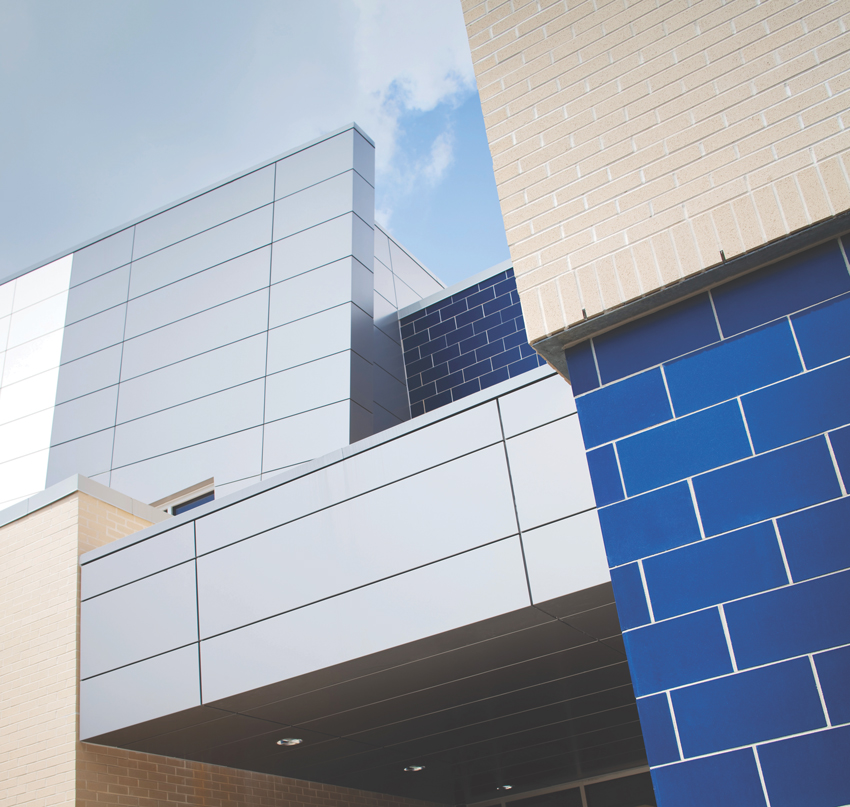
Masonry products are already engineered to fulfill the requirements of LEED v4.
LEED Credit: Materials and Resources
As mentioned above, the category of Materials and Resources (MR) is the one to watch for potential credits earned by building materials. The heavily revamped credit class applies life-cycle thinking at the whole-building and product level, with credits earned for maximum material reuse and a design that ultimately has a lower impact on the environment. In LEED 2009, the Materials and Resources category awarded points in credits focused on the attributes of recycled content, regional materials, rapidly renewable materials, and certified wood, as well as reuse of materials and construction waste management. LEED v4 takes an entirely different approach. The focus of MR in LEED v4 is on product transparency. Six of the 13 possible MR points relate to product ingredient disclosure, including EPDs, supply chain reporting, and material ingredient reporting. Other significant changes in the MR category include the addition of whole-building life-cycle assessment and the elimination of regional materials as a stand-alone credit. The credits that form the MR category in LEED v4 are shown in Table 1. Credits relevant to masonry products are detailed in the following paragraphs.
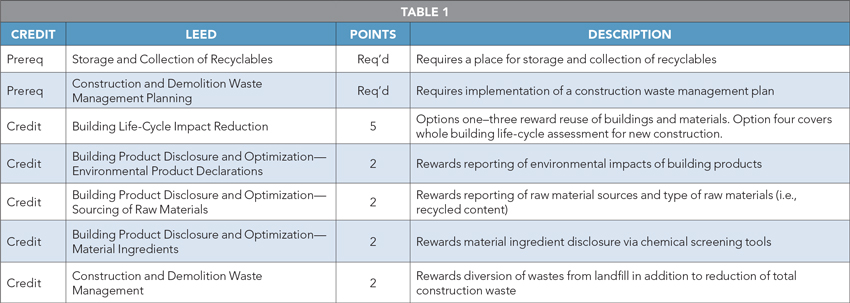
Building Product Disclosure and Optimization—Environmental Product Declarations (EPD). This MR credit asks manufacturers to verify a specific product’s life-cycle effects, with an EPD representing the best path to credit achievement. Similar to nutrition labels on food products, EPDs document impacts generally from raw material to manufacturer. One point can be earned if at least 20 different permanently installed products that have EPDs are used. Accordingly, a masonry or other product for which the manufacturer has developed an EPD can contribute to credit achievement. Not all EPDs are created equal, however. Product-specific, ISO-rated EPDs will earn full-credit value, while generic industry-wide EPDs will only receive half-credit value.
Building Product Disclosure and Optimization—Sourcing of Materials. Option 2: Leadership Extraction Practices awards one point if at least 25 percent by cost of the total value of permanently installed products on the project meet at least one of the responsible extraction criteria. Responsible extraction criteria include the use of recycled content materials and the use of salvaged materials. It is important to check the recycled content of a product or contact the manufacturing facility, which may have the ability to add recycled content to other CMUs.
Building Product Disclosure and Optimization—Material Ingredients. Option 1: Material Ingredient Reporting awards one point if at least 20 different permanently installed products report chemical inventory of the product to at least 0.1 percent (1,000 ppm). Reporting options include using Chemical Abstracts Service Registry Numbers (CASRN), health product declaration (HPD), or cradle-to-cradle certification. In the masonry industry, manufacturers are in the process of publishing HPDs for their products.
Construction Waste Management. Projects can earn up to two points in this credit for either diversion of waste or minimization of total construction waste on the project. Many masonry products are recyclable. Further, use of these products minimizes construction waste on-site because their modular nature minimizes on-site cutting. Wood structural products may not fare as well here as the sheathing and plywood required in a wood-framed structure can result in waste at the construction site.
LEED Credit: Energy and Atmosphere
Optimizing Energy Performance. This credit, worth up to 18 points, awards points for reduction in building energy use as compared with baseline requirements based on ASHRAE Standard 90.1-2010. All concrete masonry can contribute toward an energy-efficient building shell, especially those that include integration of insulation. The benefits of thermal mass provided by concrete masonry include moderation of indoor temperature swings and delayed heat transfer. Insulated concrete masonry units provide an added advantage in meeting energy-efficiency goals. Systems that use molded insulation inserts can provide up to a 16.2 R-value, and foam panel systems provide a 9.2 R-value. Particularly, masonry systems where the insulation is part of the product may have an advantage over wood framing simply because in the latter, insulation materials must be added, increasing construction time and the potential for error.
LEED Credit: Indoor Environmental Quality
Low-Emitting Materials. This credit, worth up to three points, focuses on volatile organic compound (VOC) emissions. This credit requires that 100 percent of the ceiling and wall materials used meet general emissions evaluation criteria to be considered a compliant category. Stone, glass, concrete, and clay brick are listed as “…inherently non-emitting and comply without any testing if they do not include integral organic-based surface coatings, binders, or sealants.” Most masonry products do not include integral organic-based coatings, binders, or sealants. It is important to note that factory-applied coatings must meet the California Department of Public Health Standard Method v1.1-2010 requirements to comply with this credit.
For Healthcare and Schools only, exterior applied products are required to comply with the VOC criteria if this credit is pursued. Masonry products without added coatings used in this application will generally comply with this requirement.
Acoustic Performance. LEED v4 for New Construction now includes a credit for acoustic performance. A credit for acoustic performance was previously only found in the LEED for Schools rating system. This credit includes sound transmission class (STC) requirements for interior walls ranging from 45 to 60 depending on the occupancy of adjacent rooms. An STC of 50 is required between hallways and adjacent rooms. Typical STC values for standard concrete masonry units range from 45 for a lightweight 8-inch unit to more than 60 for a fully grouted 12-inch unit. Some masonry wall systems have an STC of 61 or more, with certain specially designed acoustical masonry units providing sound absorption at all frequencies—even low frequencies that can be hard to control. Acoustics is clearly one area where masonry building products will have an advantage over wood or steel materials.
Other LEED Credits
The LEED Rating System also includes credits for Innovation and Regional Priority. Innovation credits vary from project to project but typically include strategies not covered in LEED, LEED Pilot Credits, or going beyond the LEED requirements. Regional priority credits give added weight of up to four points to credits identified by USGBC’s regional councils and chapters. In many areas of the country, Sustainable Sites credits related to rainwater management and heat island effects are identified as regional priority credits. Another area where masonry products may be able to contribute is the LEED Pilot credits for Resilient Design. One point is earned for each credit met in the areas of: assessment and planning for resilience, design for enhanced resilience, and passive survivability and functionality during emergencies. These credits recognize projects that are planned and designed to function and/or quickly return to normal operation after extreme events or disasters, either natural or manmade. Masonry’s advantages here include noncombustibility, impact resistance, and ability to withstand flooding or other water damage without developing mold or other moisture-related problems. Masonry’s thermal mass also enhances passive survivability and functionality.
Solutions Best Suited to Meet LEED v4 Requirements
With sustainable building and a more rigorous LEED rating system, manufacturers are continually developing innovative solutions that provide architects with increased performance and aesthetic benefits coupled with ease and efficiency of installation. A systems approach that incorporates several elements for a total cladding solution is increasingly being adopted in the construction industry, as these products offer considerable efficiencies as well as installation and cost saving advantages, contributing to the sustainability of the product and compliance with evolving codes. One critical area systems have an advantage is installation. Proper installation is vital to the effective functioning of any wall assembly, and installing wall assemblies with numerous elements can be time consuming, costly, and prone to error. As a single-pass installation, these all-in-one products simplify the process, eliminating the need for adding insulation, moisture management, and finishing materials, saving associated labor costs and improving accuracy.
Several masonry systems are discussed below.
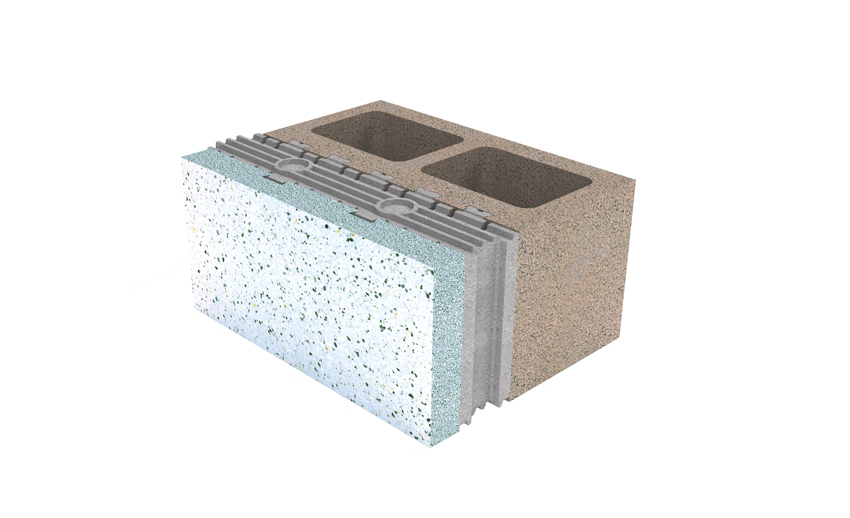
Insulated concrete masonry systems can have R-values of more than 16.
Insulated Concrete Masonry Systems (ICMS)
The ICMS is comprised of a preassembled structural masonry unit (CMU), molded expanded polystyrene (EPS) insulation insert, and thin veneer face. It is installed as a complete assembly and is fully thermally broken. Some ICMS utilize proprietary EPS foam insulation material, which has been shown to be the best performer among rigid foams in retaining the least amount of moisture—a situation that favorably impacts thermal performance.1 In terms of moisture management, some closed-cell foams like EPS have a Class III Vapor Permeability rating of between 2.5 and 5.5 perms depending on thickness and density, meaning that this type of continuous insulation is more permeable to water vapor, reducing the likelihood of mold, mildew, and structural damage. ICMS with stainless steel ties offer protection in various extreme situations. Because it does not readily corrode, rust, or stain with water as does ordinary steel, stainless steel anchors can be effective in salt water or coastal environments. Another moisture protection advantage in these systems is the fact that horizontal gaskets have drainage holes to channel water down and away from the building, which is particularly useful as the building ages and water infiltrates cracks in the mortar.
ICMS systems provide the designer with flexibility as it is adaptable in size, shape, and density, which eliminates the need to glue together multiple boards to achieve the desired insulation thickness—a characteristic that enables designers to achieve R-value targets in a thickness-constrained application. As codes evolve and R-value targets become ever more stringent, ICMS is considered perhaps the best opportunity to easily adapt, as a slight increase in insulation thickness can provide the necessary thermal performance.
Foam Panel Systems
Another energy-efficient option is a foam panel system. These systems are relatively new to the market and provide continuous insulation (CI), which is important because whenever a layer of insulation is interrupted, its effective R-value is reduced. The systems consist of three primary elements. Foam insulation panels that include premolded cells on the outside face form the pattern for installing masonry units. Specially designed anchors secure the foam panels solidly to the wood, steel, or concrete masonry structure of a building. Second are the actual masonry units, which insert easily into the cells of the foam panels for quick installation, and can include stone, clay, concrete brick, or other options. Third is mortar, with some products using a preblended, proprietary mortar that complies with ASTM C270 and enhances pumpability, bond strength, flexibility, and dimensional stability. Moisture management is built into the foam system as drainage channels on both sides of the panel divert any moisture that has penetrated the wall downward and away from the structure so there is no buildup of water within the panel system. These systems also attain R-value targets that create energy savings and reduce heating and cooling costs with minimum thickness. The layer of continuous insulation outside the framing yields R-values as high as R-13.1. An independently conducted ASTM C1363-05 Thermal Performance Test determined the R-value of certain foam systems to be as high as R-9.2 steady state, which is equivalent to an R-19.2–20 when taking into consideration the thermal mass benefits of all system components. A key attribute of foam systems, in fact, is their ability to reduce energy cost more than any other cladding system, with an unmatched R-9.2 steady state insulation value.
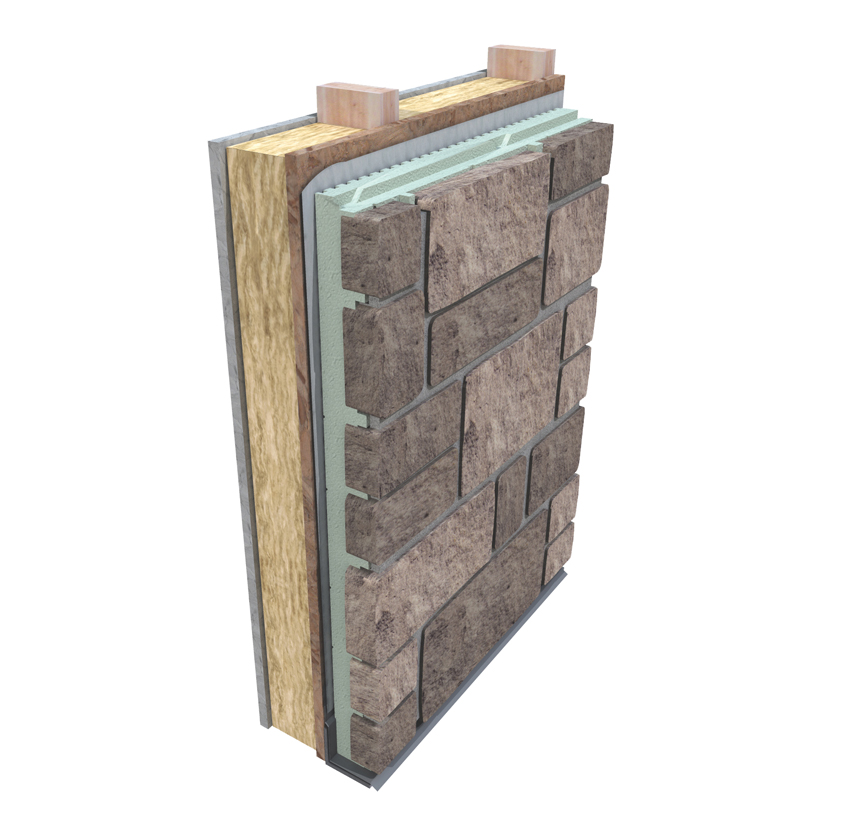
Source: ASHRAE Handbook of Fundamentals, ColoradoENERGY.org and Vinyl Siding Institute Inc.
High-performance foam systems can have an R-value of more than 9.
Foam systems pay substantial dividends in other areas as well. Some systems have been proven to resist wind speeds of more than 140 miles per hour. They can also have an STC rating of 61 dB when tested in accordance with ASTM E90d, which is not only desirable particularly in multifamily structures but meets new acoustic requirements prescribed in LEED v4. In rigorous fire testing per NFPA 285 and ASTM E119 standards, foam systems have proven their ability to be used over any exterior-rated assembly without changing the assigned hourly rating, allowing compliance with a 2-hour rating.
Integral Water Repellent Admixtures in Block and Mortar
Another effective masonry system is one with an integral water repellent. Manufacturers now offer water repellent admixtures in both block and mortar which, if used together, offer superior moisture control and protection against all types of moisture infiltration.
Because untreated concrete masonry units typically absorb water through capillary suction or wicking, the anti-wicking action of an integral water repellent will minimize the amount of water absorbed and enable any water that has breached the surface to drain toward flashing and weep holes. No film forms on the surface of the masonry as a result of the integral water repellent, nor is the unit impervious to moisture, which means the masonry remains breathable.
The newer polymeric admixtures have shown a better bond between units and mortar, though the air content has varied by manufacturer. High air content in mortar lowers the compressive strength and can reduce the bond between units. Low air content, by contrast, reduces the freeze-thaw resistance of mortar. Polymeric admixtures also provide a denser, more uniform unit as well as moisture control and limited risk of efflorescence. The admixture is incorporated at the plant, ensuring even distribution throughout the concrete mix. Especially effective in lightweight concrete masonry units and single wythe construction as added protection against water infiltration and wind-driven rain, an integrated water-repellent agent assures design professionals that the product will be executed as specified and in the proper proportion for maximum protection.
While an integral water repellent minimizes moisture in a building, the joints are still susceptible to water infiltration—a reality that necessitates an integral water repellent in both masonry units and mortar for full protection. Integral water repellent mortars are available in liquid and powder form, with the liquid admixture applied on-site at the mixer. Powders are typically found in preblended mortars. Each type of mortar is available in Type M, S, and N compressive strengths in compliance with ASTM C270 and is engineered as a preblended mortar for consistency, workability, and yield, providing factory-controlled mixes, batch to batch, compared to field-mixed mortars. In addition to creating a superior bond, these mortars can be formulated for extended board life, eliminating retempering in hot or windy conditions. Board life is a job-site-related term used by masons to define the working time of the mortar and for them to assure a proper application. Jobsite conditions, such as high ambient air temperatures, sunlit walls versus walls in the shade, windy conditions, etc., may affect the board life, depending on the overall performance or water retentivity of the mortar. In the event that the board life is reduced by job-site conditions, retempering, which is the addition of water to the remaining mortar in the mixer or mortar pans, is permitted once during the plastic stage. However, retempering of colored mortar may affect the final color. Specially engineered mortar mixes with integral water repellents have been formulated for such special applications as high-moisture environments, coastal climates, historic renovation projects, or where cement based mortar is the preferred material.
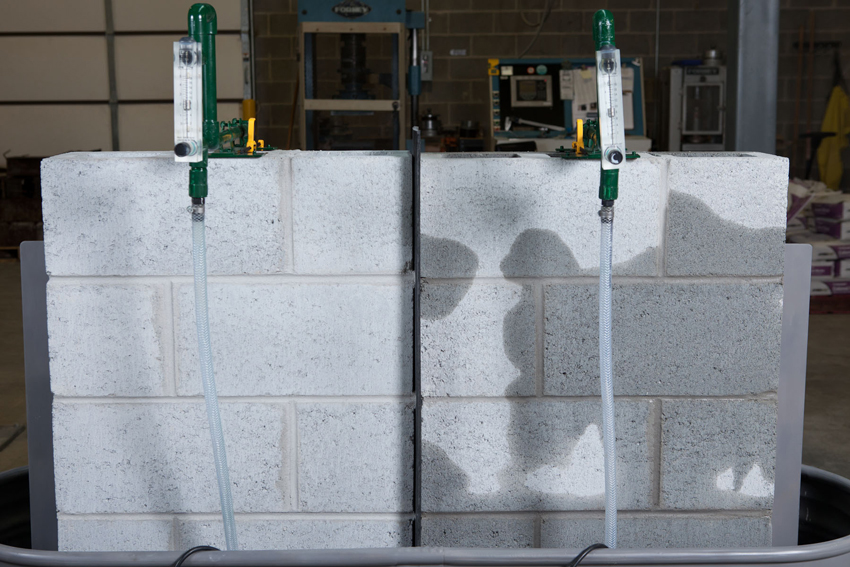
Masonry with integral water repellent mortar after 72 hours.
In results of testing conducted by the National Concrete Masonry Association, the most advanced preblended mortar products have demonstrated up to an 8 percent increase in flexural strength, significantly decreased resistance to water absorption, and a nearly 50 percent longer board life than untreated mortars. Other specifications for masonry products with integral water repellents include the following:
- ASTM C91: Standard Specification for Masonry Cement
- ASTM C150: Standard Specification for Portland Cement
- ASTM C207: Standard Specification for Hydrated Lime for Masonry Purposes
- ASTM C1714: Standard Specification for Preblended Dry Mortar Mix for Unit Masonry
- ASTM E514: Standard Test Method For Water Penetration And Leakage Through Masonry
- TMS 602: Specification for Masonry Structures
LEED v4: Are You Ready?
Now is the time to prepare for full implementation of LEED v4. Beginning November 1, any project pursuing LEED must do so under LEED v4. LEED v4 is significantly revised from LEED 2009. Some of the issues to consider are listed below.
Long-term benefits. LEED v4 may have just mainstreamed life-cycle thinking. In any event, it encourages life-cycle assessments of products, and stresses the importance of looking beyond the initial dollar costs and considers the product’s environmental impacts over the lifetime of the building. The amount of maintenance and repair a product will require is a key factor in its life-cycle cost. Under LEED v4 expanded credits for reusing existing buildings and a new credit on performing a whole building life-cycle assessment are available.
Increased energy efficiency. Buildings must be at least 5 percent better than ASHRAE Standard 90.1-2010. The previous edition required compliance with the 2007 edition of Standard 90.1. Experts estimate this to be an increase in stringency of approximately 18 percent. Whole building energy simulation is the preferred compliance path in LEED v4.
Urban heat island calculation. A significant change in LEED v4 combines the credits for roof and non-roof surfaces in a single urban heat island calculation.
Material ingredients. New credits in LEED v4 MR section require documentation of building product raw materials and their effects on the environment. These include material ingredient reporting and environmental product declarations.
Material sourcing. Where products come from matters. Other new MR credits include sourcing of raw materials and a new take on regional materials that eliminates the stand-alone credit and instead adds weighting to materials sourced within 100 miles of the project site.
Acoustic performance. LEED v4 now includes a prerequisite for minimum acoustic performance in schools and a credit for acoustic performance in most other versions of the rating system.
Construction waste. With a LEED v4 credit involving construction waste on-site and off-site, it behooves architects to lean toward modular sizing, where you specify exactly what you need with little overage.
Multiple benefits. In selecting a project for energy efficiency, consider in what other areas it may carry advantages. If a masonry product, say, is selected for its energy-saving properties, architects will also reap dividends in the areas of aesthetics and acoustics. It is this type of synergy that is a key objective of LEED v4.
Masonry products can play a significant role in achieving the above-mentioned credits.
LEED v4 and Masonry: A Win-Win
LEED v4 is the most advanced version of the predominant green rating system in the United States. Through it, the U.S. Green Building Council has taken a new stance on what constitutes sustainable design, requiring more participation from manufacturers in terms of rigorous disclosure and measurement of the full life-cycle impacts of their products. As a result, architects must be ever more aware of the ramifications of not only the products they select, but the manufacturers that produce them. Masonry inherently is a green building material, by virtue of its ingredients, its production process, and its thermal mass. Further, masonry systems deliver greater efficiencies and lower costs than a combination of individual components, further adding to the ability to meet and exceed the requirements of LEED v4. As architects approach LEED v4, and particularly its challenging new Materials and Resources credits, they should be aware of solutions that are best suited to quickly meet these new requirements. In this endeavor, manufacturers of advanced masonry products and systems have a valuable part to play.
End Notes
1“Ask the Expert.” FacilityManagement.com. Continental Business Media LLC. 2015. Web.
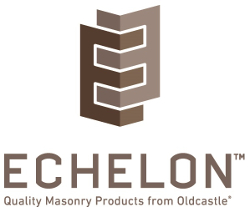 |
Echelon is the consolidated brand for all masonry products and services of Oldcastle Architectural including Trenwyth® Architectural Masonry, Artisan Masonry Stone Veneers®, Quik-Brik® Concrete Masonry Units, Amerimix® Bagged Goods and a complete portfolio of Performance Upgrades. As a single source masonry portfolio solution, Echelon delivers consistent, reliable product manufactured locally at more than 170 locations and delivered by an unrivaled logistics network. For more information, call (844) 495-8211 or visit EchelonMasonry.com |


